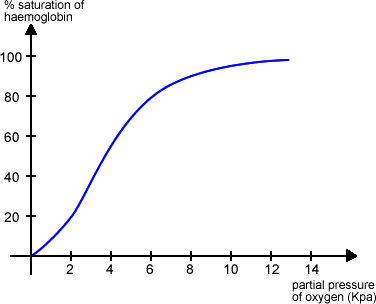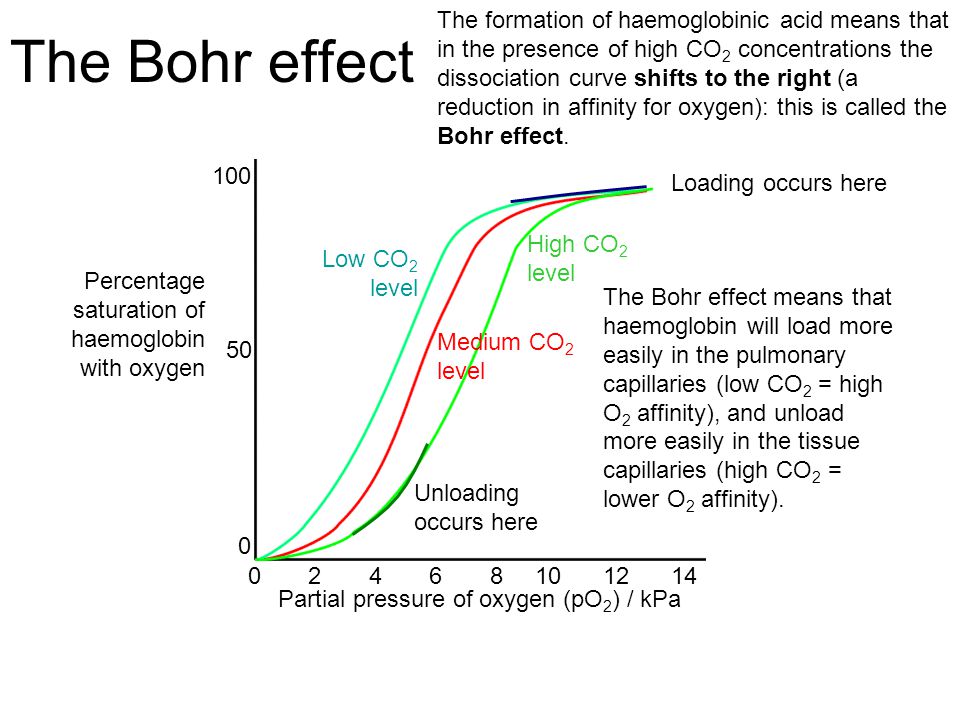Mass Transport
- Created by: anika01
- Created on: 26-01-19 12:11
Haemoglobin
Haemoglobin- Globular protein that transports oxygen around organisms efficiently. It has a quaternary structure that can load (associate where gas exchange occurs) and unload (release O2 when needed). It is made up of 4 polypeptide chains that (a-helix and B helix which link together to form a spherical shape). Each molecule forms a complex with a haem group, and contains Fe2+ ions. Each Fe2+ ion combines with an O2 molecule.
Oxygen dissociation curve
- Curve is initially shallow as it is more difficult for the first O2 moelcue to bind (due to tightly packed shape).
- once the first molecule has bound, shape of haem changes + makes it easier for other molecules to associate. positive cooperativity (smaller rise needed in partial pressure to bind).
- gradient flatterns out (theory= easier to bind) BUT (reality= not likely to find empty site to bind).

Bohr effect- Effect of CO2
- In presence of CO2, Haem has lower affinity for O2. The greater the conc. of O2, the more readily haem reases it.
- Lungs- CO2 conc. is lower which increases affinity of haem for O2. Curve shifts left.
- Respiring tissues- CO2 conc. is higher which lowers affinity of haem for 02. Curve shifts right.
How properties of haemoglobin relate to the environment they are in;
- Animals with low partial pressure has evolved haem with high affinity for O2. It allows them to extract as much available O2 as needed. Organisms= high altitude/in water.

Transport system of organisms
Why do organisms move substances around their body;
- small organisms= no circulatory system because the substances they need can be diffused in and out
- larger organisms= Surface area to Volume ratio not large enough- diffusion alone is not sufficient hence the need for a circulatory system.
Need for a circulatory system depends on;
- how active the organism is
- surface area to volume ratio
Features of a trasnport system
- Suitable medium- used to carry substances and is usually water based for easy diffusion
- Form of mass transport- to move medium in bulk over large distances
- Closed system of vessels- contains medium and has branching network to deliver substances all around the body
- Pressure gradient- to move medium within the vessels
- Mechanism to maintain mass flow in one direction- intercoastal muscles.
Circulatory system of animals
- Double circulatory system
- heart consists of two pumps
- pump 1- pumps blood to lungs to be oxygenate
- pump 2- larger pump to pump blood arounf the body to supply major organs with O2.
Why does the heart have two pumps?
- Two seperate pump allow oxygenated blood to be pumped around the body at higher pressure than just one pump.
- blood can therefore pass through thin capillaries- of lungs- to collect O2. There is a large decrease in pressure of blood.
- blood returned to heart to increase pressure, before distributing around the body
- if blood did not flow around the body, then it would not return to the heart- then blood flow to the rest of the body would be too slow to supply oxygen to active tissues at the rate needed.
Risk factors for cardio vascular disease
- smoking - high LDL cholestrol
- diet with high salt - high blood pressure
Structure of the heart- need to finish

- Atrium- thin walled and elastic, the atrium can stretch when it fills with blood
- ventricle – thick muscular wall to pump blood around the body or to the lungs.
- pulmonary- to do with lungs
- coronary- to do with heat
coronoary artery- branch fro the aorta after left ventricle, which supplies heart with the blood so cardiac muscle cells can respire.
blockage of coronary artery- blood supplu to heart tissue stopped so no glucose and O2 for respiration. (Can lead to localised blockage or major blockage).
Cardiac cycle
Right side
- Vena Cava brings deoxgynated blood to the right atrium
- Atrium full with blood= high pressure and low volume + muscles in atria then contract
- Blood flows through into ventricles through the atrioventricular valve
- ventricles relax so the volume increases and pressure decreases
- When atria is empty and ventricles are full the blood flows through the semilunar valves to the pulmonary artery, then travels to the lungs to become oxygenated blood and remv=ove CO2.
Left side
- Pulmonary vein brings oxygenated blood from lungs into the left atrium
- Atrium fill up with blood= volume increases and pressure decreases as its relaxed
- Left atrium contracts after it is full, so pressure increases and volume decreases
- the blood then flows to the left ventricle through the open atrioventricular valves
- Left ventricle fills up so ventricle contracts and blood flows into the aorta through the open semi lunar valves
- Atrioventricular valves close to prevent backflow and tendons stop valves inverting
Pressure and volume change during cardiac cycle

structure of blood vessels
Arteries-The function of the arteries is to carry blood rapidly, under high pressure from the heart to the tissues. Thick muscle and elastic layers control blood flow and maintain high pressure. The elastic layer also smooths pressure surges caused by heartbeats. They do not have valves.
Aterioles- They carry blood at lower pressures and control the flow between the arteries and capillaries. The muscle layer is thicker than arteries to give more control over flow. The elastic layer is thinner because the blood pressure is lower.
Veins- They return blood slowly and at low pressure from the capillaries to the heart. They have thinner muscular and elastic layers because the blood is at a lower pressure and the veins cannot control its flow. They contain valves throughout to ensure that blood flows in the correct direction.
Capillaries- The flow of blood is slower and they deliver blood to all tissues so that substances can diffuse in and out. Their walls are thin so that diffusion can take place easily. They are numerous and branched to give a large surface area for exchange. The lumen is narrow to bring red blood cells closer to the cells, reducing diffusion distance. There are also spaces in the endothelium to allow white blood cells to leave and fight infections.
Tissue fluid
Blood
- fluid in blood cells
- concsists of other large protein molecules
- plasma- fluid in cells
Tissue fluid
- plasma part of the blood
- it doesnt count as blood due to the lack of cells and plasma protiens
- allows exchange
- surrounds all tissues
Where it is formed
- formed only at capillary beds
- Hydrostatic pressure builds up due to ultra-filtration- as diameter decreases (arteries to arterioles to capillaries), the blood pressure increases (hydrostatic pressure)
Tissue fluid 2
- Hydrostatic pressure of blood is high at the arteriole end as it goes goes smaller in diamter- so blood pressure builds up
- Fluid/water/soluble molecules pass out by ultra filtration (reject plasma) and so the large proteins and plasma remain.
- This lowers the water potential (as there are more proteins and less water), so the water moves back into teh venous end of capillary by osmosis and diffusion.
- The lymph system collects any excess tissue fluid
- Lymph returns to the blood/ circulatory system and returns tissue fluid to the vein.
Why this happens
- O2 and glucose used for repsiration
- Urea is poisonous and thus needs to be excreted
Translocation
- In the leaves(source) sucrose (made by fructose and glucose-disaccharide which is bonded by glycosidic bonds) is produced by photosynthesis
- This diffuses into companion cells, down a conc gradient by facilitated diffusion
- Companion cells move sucrose into phloem vessels via co-transport with H+ ions
- Water potential decreases in phloem-
- So, water from xylem moves by osmosis down the water potential gradient into the phloem
- Hydrostatic pressure increases in the phloem
- The contents of the phloem move by mass flow down the pressure gradient to the roots/shoots (sinks)
- Phloem can transport both up and down
- Sucrose is stored/used by sink cells which maintains the pressure gradient.
Translocation
- In the leaves(source) sucrose (made by fructise and glucose-disaccharide which is bonded by glycosidic bonds) is produced by photosynthesis
- This diffuses into companion cells by facilitated diffusion
- Companion cells move sucrose into phloem vessels via co-transport with H+ ions
- Water potential decreases in phloem- down the water potential gradient
- Hydrostatic pressure increases in the phloem
- The contents of the phloem move by mass flowdown the pressure gradient to the roots/shoots (sinks)
- Phloem can transport both up and down
- Sucrose is stored/used by sink cells which maintains the pressure gradient.
Factors affecting translocation
Windspeed- the greater the windspeed the higher the levels of transpiration. gretaer windspeed means water molecules are moved away from the stomata, so there is an increase in the water potential gradient= waer evaporation is faster.
Humidity- the greater the levels of humidity, the lower the rates of transpiration. water potential gradient is lowered, so less evaopration occurs.
Temperature- the higher the temp, the faster the rate of transpiration. Water molecules have more kinetic energy to inrease the thermal energy so more evaporation occurs.
Light intensity- the greater the light intensity, the higher the levels of tranpiration. More stomata are open and thus there is a larger surface area and so evaporatio rates are higher. Light intensity opens stomata to allow CO2 to go for photosynthesis.
CO2 levels- the higher levels of CO2, the higher the rate of transpiration. More stomata open, which creates a larger surface area, and so evaporation rates are higher.
Plants resond to increased transpiration rates by closing stomata. (+) = less water loss (-) = allows CO2 to come in for photosynthesis.
Comments
No comments have yet been made